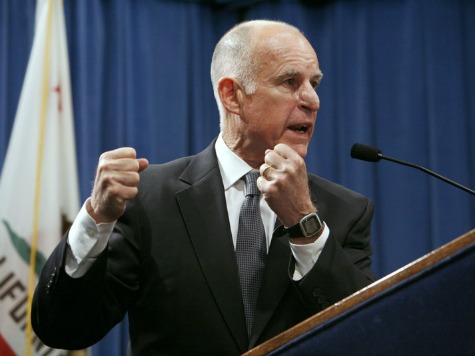
There is nothing like the threat of insolvency and a downgrade to junk bond status to motivate traditionally liberal politicians to abandon the environmentalists who heavily fund their campaigns. Last week, Governor Jerry Brown of California tossed one of his core campaign-bundling constituency under the bus at a bill-signing event in downtown Los Angeles.
As Brown signed his third measure this year that dramatically narrows the “sustainable” crowd’s ability to use litigation to delay or kill capital projects, the governor said it is time for “big ideas and big projects,” especially ones to “get people working.” With the pace of public insolvencies and Chapter 9 municipal bankruptcy fillings accelerating across the U.S., Brown is the vanguard for high-profile progressives willing to bet that capitalism can pull them back from the precipice of disgrace and potential recall.
For most of Edmund G. “Jerry” Brown Jr.‘s first tour as governor from 1975-1983, Gray Davis served as his Chief of Staff, and when Brown was campaigning for President, Davis ran California in Brown’s absence. In 1998 Davis was elected governor by an overwhelming 20% margin. In the next 1,778 days, Davis went on a liberal borrow-and-spend blitz by signing 5,132 bills; including huge pension spikes for public employees, public control of electricity purchasing, substantial increases in school spending, the nation’s first state law requiring automakers to limit auto emissions, and even an attempt to pass gun control. But when the economy turned down after 9/11 and the credit rating agencies’ downgrades sent California into a financial crisis, Davis became only the second governor in American history to be recalled by voters.
The recall of Davis sent a scare to politicians across the nation about the need to control spending and become more pro-business. But with real estate prices skyrocketing, state and local government revenues exploded to the upside. Spending accelerated even faster than rising revenues as governments borrowed heavily on the hope of an endless rise in property and sales taxes.
When the Great Recession hit in 2008, state and local governments kept borrowing and spending, because they enjoyed huge “stimulus” transfers from the Obama Administration and a two-year lag before tax revenues began to fall. But In 2011, state and local spending fell for the first time since 1946. This year, government entities face steep budget deficits and are struggling to pay off debts accumulated over prior years.
The Moody’s and S&P credit rating agencies, which provided the “investment grade” credit ratings and encouraged investors to buy many dicey municipal bonds, now fear they may have liability and are actively slashing many ratings. As ratings levels have hit “junk bond” status, 26 municipalities filed for bankruptcy since 2010. Three California cities have filed bankruptcy over the last 60 days and Fresno, Duarte, Compton, San Jose and other cities have acknowledged they are in financial crisis.
More ominous, for sixty years municipal debt increased annually, but this year for the first time the municipal bond market will face the “August Cliff”. This is an event where more money will flow out of government coffers to pay-off maturing debt than will come in from expanding new bond sales. With credit ratings falling and media-driven fear rising about the “Mounting Muni Meltdown“, there is little time before conservative investors become reluctant to put their cash back to work in municipal bonds.
Governor Brown is on a pro-development tear. He shocked the “greens” last week by joining U.S. Department of the Interior Secretary Ken Salazar in announcing plans to build two massive tunnels under the California Delta — at a cost of $23.7 billion — to carry water from the Sacramento River to the California Aqueduct, quenching Southern California’s thirst for new land development while generating more property and sales taxes. The next day, he dedicated the 117-mile Sunrise Powerlink transmission line that can carry 1,000 megawatts of energy from the Imperial Valley to San Diego – the first major new power lines to connect to San Diego in over 25 years.
Governor Brown is painfully aware that California already has the second lowest state municipal bond rating in the United States and that Moody’s recently warned they plan to issue California a downgrade soon, possibly to junk. My analysis indicates that approximately 20% of cities, 30% of redevelopment districts, and a number of counties in California may file for bankruptcy in the next 2 years.
Jerry Brown’s father, former California Governor Pat Brown, first ran for State Assembly as a Republican in 1928 but lost and later joined the Democratic Party. Pat Brown’s two terms as governor were marked by working closely with the pro-growth private sector to build the enormous California Aqueduct, enact the California Master Plan for Higher Education, and found the state economic development commission.
Governor Jerry Brown seems to have re-embraced his father’s belief in building infrastructure to support private sector growth to rehabilitate California. When Governor Jerry Brown was asked why he has signed three bills this year to limit challenges to major infrastructure projects by the state’s restrictive California Environmental Quality Act, Brown responded, “I’ve never seen a CEQA exemption that I don’t like.”

COMMENTS
Please let us know if you're having issues with commenting.